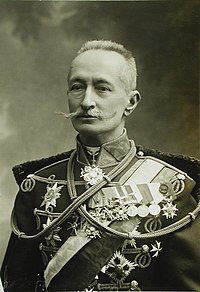Tretyakism: Difference between revisions
No edit summary |
|||
| Line 14: | Line 14: | ||
== History == | == History == | ||
Tretyak led the Workers' Revolutionary Army during the Chistovodian Civil War, to great success. Unlike many contemporary communalist revolutionaries at the time, the WRA was successful in | Tretyak led the Workers' Revolutionary Army during the Chistovodian Civil War, to great success. Unlike many contemporary communalist revolutionaries at the time, the WRA was successful in assimilating many elements of the existing military structure. Babych had instituted policies that had decentralised the Chistovodian army, placing it under the control of regionalist commanders who's authority ranged from but a face for the President or quasi-governors for the sections they operated in. Tretyak had served in the Chistovodian army for much of his life and his defection was viewed as a great boost of popularity for the CSWI, and was fortunate to be in command of the most modernised elements of the Chistovodian forces at the time. | ||
Much of the success of the WRA has been attributed to Tretyak; even by the CSWI itself. Whilst Tretyak never coined a terminology of 'Tretyakism', he did codify his own beliefs down in several journals during the war -- as well as in its aftermath. After denying an invitation to serve as the first President of the nation, he collected his thoughts in the 'Treatise of the Soldier Worker' where he outlined his beliefs in the necessity of the armed struggle, and the necessity of a yet classified strata of society that he called 'the soldier workers'. | |||
== Tretyakist Policies == | == Tretyakist Policies == | ||
Revision as of 21:41, 15 December 2021
Tretyakism is the means of governing society and implementing social and economic policies which were either implemented or attempted to be implemented in Chistovodia during the years of 1949 - 1964. Though instituted by the Chistovodian General Congress of the time, its name is derived from General Kostyantyn Tretyak -- the leader of the revolutionary forces during the Chistovodian Civil War.
Tretyakism was implemented under the joint plans of President Eduard Bojchenko and Premier Kazymyr Shostak, both of them staunchly of the belief that the workers' revolution was an international armed struggle that should be continuously fought at all opportunities. Bojchenko and Shostak were both of the belief that councilism in the Asterias was under an existential threat of reprisal from the victorious powers of the Great War; who had been given enough time to regroup and consolidate themselves. Unsuccessful councilist uprisings in Asteria Inferior, and the subsequent tension between the Vinalias, led to the development of an ideology that sought to prepare Chistovodia to fight 'an entire continent of enemies', by arming its population and gearing the socialist state to become 'an armed intermediary' before its own dissolution.
Bojchenko forcibly conscripted and armed the population, believing it to be a way to further the policies of 'Councilism in All Countries' whilst Shostak developed the concept of the 'soldier worker': a yet undescribed section of the proletariat that was prepared and willing to fight to overthrow the bourgeoise as his dedicated profession. Both oversaw the development of 'hierarchical command' with the Chistovodian Section of the Workers' International and the 'militarisation of socialism', as well as the pursuing of social policies that regimented daily life to mirror that of a military unit to shift the nation into phase of 'total conflict'.
Economically, Bojchenko oversaw the creation of numerous specialised Presidium positions for industrial expansion whilst Shostak redeveloped the ministry of agriculture by decree of the General Congress into complete state control, removing many of the local authorities that had been set up by the initial revolution. Through contacts in the AIS, foreign thinkers, strategists, economists and inventors were hired to help prepare for what was regarded to be an 'inevitability' of conflict.
History
Tretyak led the Workers' Revolutionary Army during the Chistovodian Civil War, to great success. Unlike many contemporary communalist revolutionaries at the time, the WRA was successful in assimilating many elements of the existing military structure. Babych had instituted policies that had decentralised the Chistovodian army, placing it under the control of regionalist commanders who's authority ranged from but a face for the President or quasi-governors for the sections they operated in. Tretyak had served in the Chistovodian army for much of his life and his defection was viewed as a great boost of popularity for the CSWI, and was fortunate to be in command of the most modernised elements of the Chistovodian forces at the time.
Much of the success of the WRA has been attributed to Tretyak; even by the CSWI itself. Whilst Tretyak never coined a terminology of 'Tretyakism', he did codify his own beliefs down in several journals during the war -- as well as in its aftermath. After denying an invitation to serve as the first President of the nation, he collected his thoughts in the 'Treatise of the Soldier Worker' where he outlined his beliefs in the necessity of the armed struggle, and the necessity of a yet classified strata of society that he called 'the soldier workers'.

